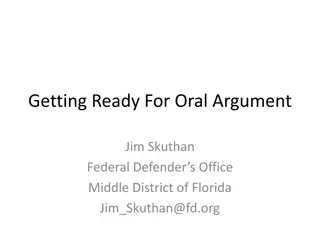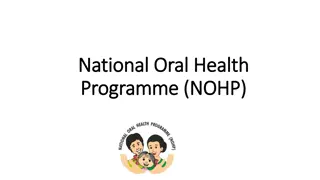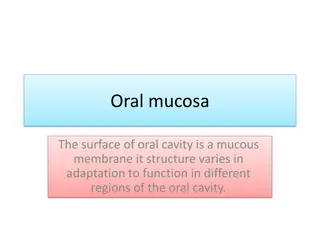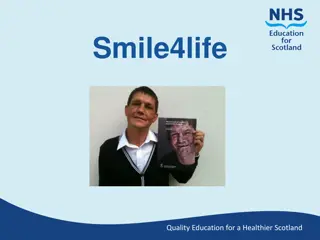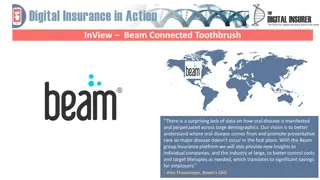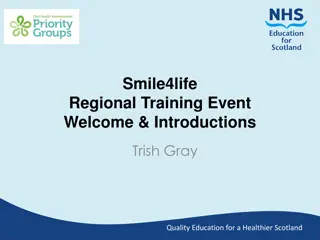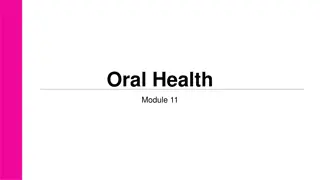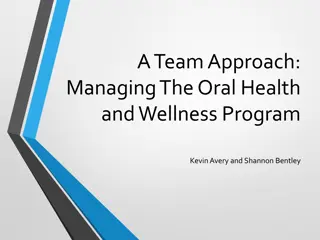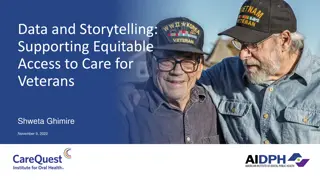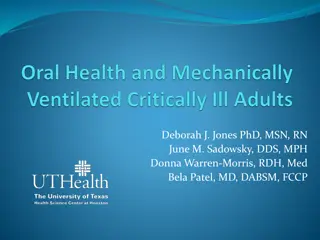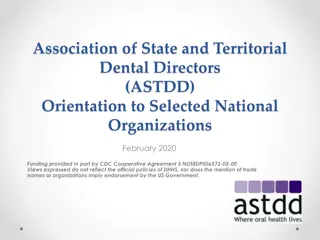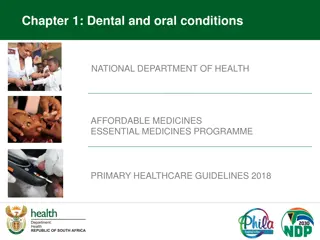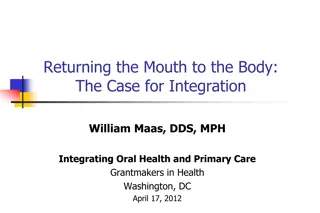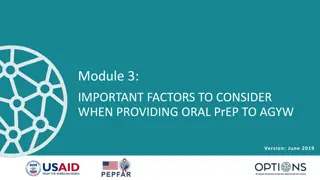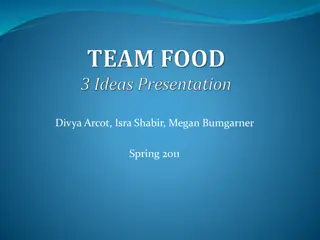Oral Presentation Techniques and Guidelines
Enhance your oral presentation skills with techniques on linguistic and non-verbal behavior, organization, and use of visual aids. Learn to engage your audience effectively and improve your public speaking confidence. Explore examples and dimensions of oral presentations to develop a strong presentation style. Master the art of effective communication and presentation delivery for academic, career, and personal growth. Overcome nervousness and refine your speech delivery with practical tips and insightful guidelines.
Download Presentation

Please find below an Image/Link to download the presentation.
The content on the website is provided AS IS for your information and personal use only. It may not be sold, licensed, or shared on other websites without obtaining consent from the author.If you encounter any issues during the download, it is possible that the publisher has removed the file from their server.
You are allowed to download the files provided on this website for personal or commercial use, subject to the condition that they are used lawfully. All files are the property of their respective owners.
The content on the website is provided AS IS for your information and personal use only. It may not be sold, licensed, or shared on other websites without obtaining consent from the author.
E N D
Presentation Transcript
+ ICS 139W Critical Writing on Information Technology Lecture 2 Emily Navarro Duplication of course material for any commercial purpose without the explicit written permission of the professor is prohibited
+Todays Lecture Oral presentation techniques Oral presentation review guidelines Influencing Policy assignment Group work PowerPoint articles
+Oral Presentations Important part of your education, future career, and your personal growth as an effective communicator Public speaking: number one fear, over death Nervousness should abate over time with practice
+Some Examples https://www.youtube.com/watch?v=YivQYeI0vys https://www.youtube.com/watch?v=kql-pvnid0s https://www.youtube.com/watch?v=ck5vVU8qQWA https://www.youtube.com/watch?v=BBthvuOQpKc
+Dimensions of Oral Presentation Linguistic behavior Non-verbal behavior Organization Visual aids
+Linguistic Behavior DO DON T Rate of speech Slow down Use pauses Speed through Intonation Speak up Use inflections Be monotone Verbal mannerisms (um, you know, like) Vary your transitional phrases Use them Response to audience questions Listen and thoughtfully respond Be dismissive
+Non-Verbal Behavior DO DON T Gestures Use them to add emphasis Death grip the lectern Movement Vary your position Be frozen Facial expressions, mannerisms Practice and watch for these Use distracting mannerisms Eye contact Focus on individuals for a few seconds at a time Try to appear comfortable Pass your gaze over the room Apparent comfort Let them see your nervousness
+Organization Structure in sections Go through main points before during and after Use effective redundancy Finish with a satisfying conclusion
+Visual Aids Effective slides are visual If something can be made a picture, then do it use bullets, not full sentences Each item no more than two lines use a consistent layout use minimal text have plenty of white space
+Visual Aids (II) A presentation is about what speaker has to say, not what can be read from slides Slides should help audience understand material, not remind speaker of what to say
+Visual Aids (II) A presentation is about what speaker has to say, not what can be read from slides Slides should help audience understand material, not remind speaker of what to say Do not simply read your slides!
+When preparing slides It is generally not good practice to create long strings of text in complete sentences and then either read them to the audience or expect the audience to read the text and listen to you say different words at the same time. They will end up either reading the slide and tuning you out, or tuning both out because text processing is sequential. If all of the information is on the slide, then they don t need you anyway. Use brief bullets to illustrate points Talk to fill in the needed information
+When preparing slides Use large, clear, readable font Use large, clear, readable font Use large, clear, readable font Use large, clear, readable font Use large, clear, readable font Use large, clear, readable font Use large, clear, readable font
+What is wrong with this slide? Clases in UML appear as rectanlges with multiple sections. The first section contains its name (defines a type) and the second section contains the class s attributes the third section contains the class s methids. Classes can be related in a variety of ways: Inheritance, association (with multiplicity optional), whole-part (agregation and composition), qualification, and interfaces. In inheritence, one class extends another and it is notated by a a white triangle points to the superclass. The subclass can add attributes and it can also add behaviors or override existing ones. With asociation one class can reference another and this is shown by a straight line drawn between classes. Also, roles can be asociated with the classes that take part in an association, shown by text on the line close to the boxes. Associations can be labeled in order to convey semantic meaning to the readers of the UML diargam. In addition to roles and labels, associations can also have multiplicity annotations, which indicates how many instances of a class participate in an association. Associations can indicate the number of instances involved in the relationship. This is known as multiplicity. An association with no markings is one to one. An association can also indicate diretcionality. If so, it indicates that the knowledge of the relationship is not bidirectional. Asociations can also convey semantic information about themselves. In particular, agregations indicate that one object contains a set of other objects. Agregation is indicated with a white diamond attached to the class playing the container role. A clas can indicate that it impliments an interface. An interface is a type of class definition in which only method signatures are defined. A class implementing an interface provides method bodys for each defined method signature in that interface. This allows a class to play different roles, with each role providing a different set of services. Interface is denooted by a hollow triangle shape on the interface end of the dashed line that connects it to one or more implementers.
+Better Classes in UML appear as rectangles with multiple sections First section: class name Second section: class s attributes Third section: class s methods Class Name Attribute : Type Attribute : Type Operation (parameter) : Return Type Operation (parameter) : Return Type Operation (parameter) : Return Type
+Colors Use visible colors Use colors for emphasis Contrast with background Avoid light on light Avoid dark on dark
+Animation Use animation sparingly, if at all Distracts from your talk Should add something to your talk
+Other Important Points Know your material Know your audience Be yourself Practice Don t apologize Expect nervousness
+Oral Presentation Review Guidelines
+Oral Presentation Review: Purpose Two ways to become a better writer: Practice Critique others work Each time we have oral presentations, we will also peer review them
+Oral Presentation Review: Logistics During/after presentation, write down comments After presentation, give comments to speaker After speaker reads them, give them to TA Comments count toward your participation grade Comment on at least 3 speakers per presentation class session Next lecture: oral presentations on system changes
+Oral Presentation Review Guidelines Linguistic behavior See earlier slide Non-verbal behavior See earlier slide Organization and content Can you follow the speaker s train of thought? Are the speaker s facts accurate? How well does the speaker appear to understand the topic? Do you agree with the speaker s conclusions? Visual aids (when used) How effective are the slides? How does the speaker interact with the slides?
+Oral Presentation Reviews Other Points Point out what part(s) of the presentation went well Provide constructive criticism
+Basic Idea Learning to write persuasively Improves your critical thinking Improves your reasoning/logic Improves your ability to weigh evidence and make decisions Write a persuasive letter to a policy maker about changing policy Take a position Recommend some action Back it up
+Topic Choose an issue: that involves technology that you care about that you know about Ideas Email spam Privacy Objectionable material on the Internet Internet sales tax
+Recipient An appropriate policy maker New law / support or oppose proposed legislation Member of congress Executive branch action Head of appropriate branch (e.g., Justice Department regarding an antitrust suit) Move public opinion President (veto legislation), editor of newspaper Address your letter properly
+First Steps Write a five- to ten-line outline List the supporting points and conclusion like a syllogism Turn this in with each revision Write your letter Based on the outline
+Syllogism A three-part logical argument Major premise All birds are animals. Minor premise All parrots are birds. Conclusion All parrots are animals. Each part expressed as Some/all/no A is/are [not] B Privacy example Collecting data on peoples search engine usage is unconstitutional. Google collects data on peoples search engine usage. Google s practices are unconstitutional (and they should therefore be banned from collecting this data.)
+Valid or Fallacious? Some cats are black. Some televisions are black. Some televisions are cats.
+Valid or Fallacious? Some cats are black. Some televisions are black. Some televisions are cats. FALLACIOUS
+Valid or Fallacious? All Texans are Americans. No Californians are Texans. No Californians are Americans.
+Valid or Fallacious? All Texans are Americans. No Californians are Texans. No Californians are Americans. FALLACIOUS
+Valid or Fallacious? No lazy people pass exams. Some students pass exams. Some students are not lazy.
+Valid or Fallacious? No lazy people pass exams. Some students pass exams. Some students are not lazy. VALID
+Valid or Fallacious? No healthy food is fattening. All cakes are fattening. No cakes are healthy.
+Valid or Fallacious? No healthy food is fattening. All cakes are fattening. No cakes are healthy. VALID
+Valid or Fallacious? The evidence says one thing. The conclusion says another. The evidence is false.
+Valid or Fallacious? The evidence says one thing. The conclusion says another. The evidence is false. FALLACIOUS
+Counterarguments Anticipate and discuss them! Generate them point by point Imagine what an opponent might say to each Do your research Talk with others Present them fairly and objectively Goal: to convince the reader that your arguments are stronger
+Audience Special consideration for persuasive writing! Ensure tone, style, and form of address are appropriate Describe the action you want them to take in the first few sentences Make the letter sendable
+Due Dates 4/15 Outline + good draft Joint editing in class 4/22 Revised outline + revised draft Editor s comments 5/6 Final letter + outline All previous versions
+Group Assignment Get into groups of four or five Come up with a position about the evilness of PowerPoint Majority rules (or just choose a side) You must participate and argue for your position, whether you agree with it or not At the end of class, turn in A thesis statement summarizing your position A list of three or more supporting points, structured as syllogisms
+Next Time Discussion (tomorrow) Using each other s instructions to build systems Bring THREE copies of your instructions But only one set of your building components Lecture (Thursday) 1-2 minute oral presentations on system change proposal



